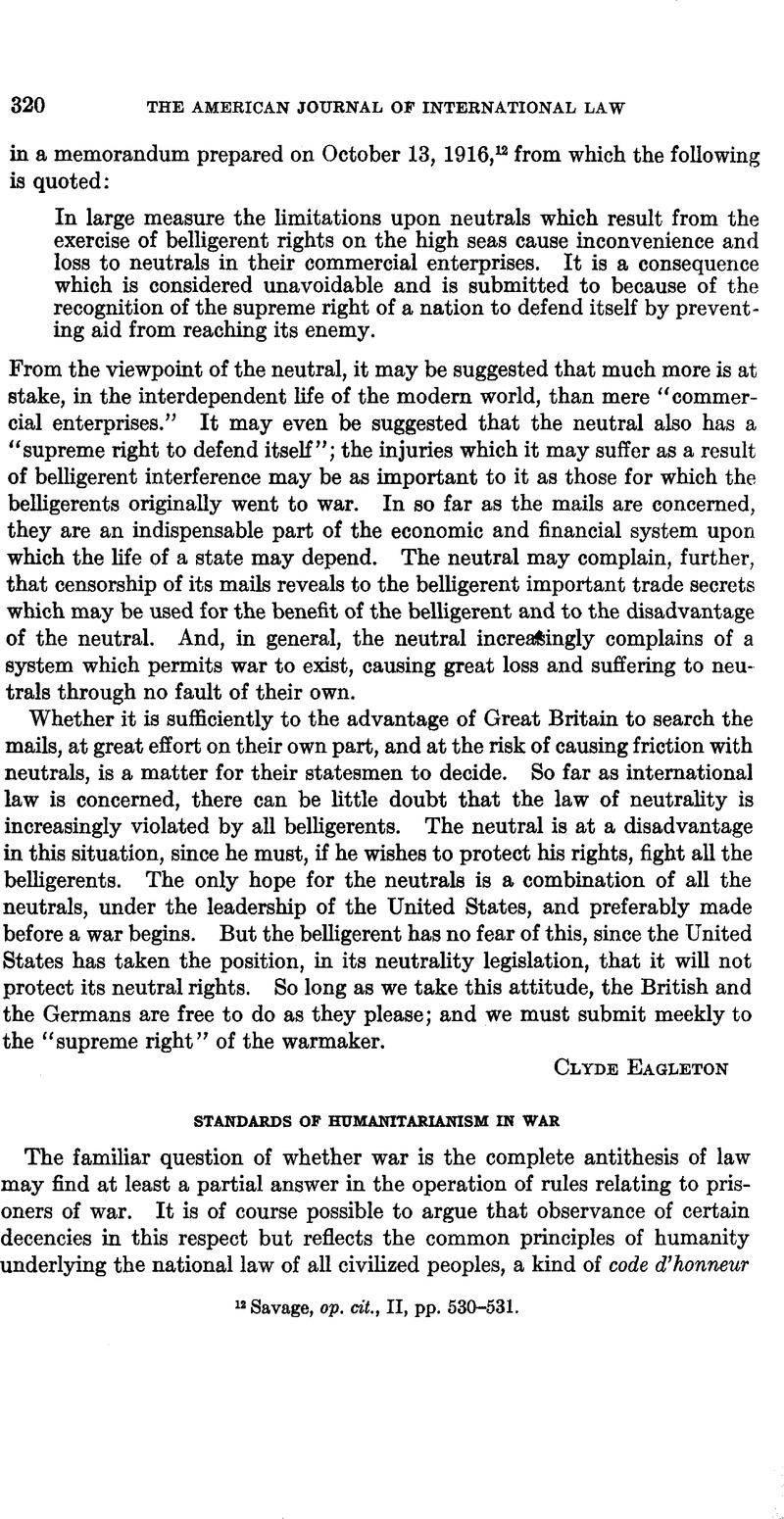No CrossRef data available.
Published online by Cambridge University Press: 12 April 2017

1 Renée Marguerite Frick-Cramer, “A propos des projets de conventions internationales riglant le sort des prisonniers,’’ Revue internationale de la Croix-Rouge, No. 74 (Feb., 1925), pp. 73–84.
2 The Cost of the War to Russia, in Russian Series, No. 12, Economic and Social History of the World War (1932), p. 135.
3 Statistics of the Military Effort of the British Empire, 1914–1920 (1922), pp. 630–631. General Pershing’s Final Report (1919) showed that on Nov. 11,1918, there were 248 American officers and 3,302 men in the hands of the Germans (p. 86). For references in this note and in the two preceding, the writer is indebted to Mr. W. E. S. Flora, of the Duke University Graduate School.
4 New York Times, Jan. 28,1940,1:3:4.
5 Revue internationale de la Croix-Rouge, No. 251 (Nov., 1939), p. 897.
6 New York Times, Feb. 6,1940, p. 15. The reference to treatment as officers may be of some practical importance, as under existing international rules officers may not be required to work in the captor country.
7 Revue internationale de la Croix-Rouge, No. 252 (Dec., 1939), pp. 961–974. For a statement on the extent to which the International Committee of the Red Cross may take steps toward investigating an alleged violation of the existing conventions or “de règies du droit des gens protégeant des intérêts humanitaires,” see the Revue cited, No. 249 (Sept., 1939), pp. 766–769.
8 8 Stat. 84, 96–98. The parties proposed to pledge themselves “to each other, and to the world.” (Dip. Corr., U. S., Sept. 10, 1783, to March 4, 1789, II (1833), pp. 52, 230, 237.)
9 8 Stat. 162, 174–176, 378–387. On these treaties generally, see Reeves, J. S., “The Prussian-American Treaties,” this Journal , Vol. 11 (1917), pp. 475–510 Google Scholar.
10 II Miller, Treaties, p. 557.
11 V ibid., pp. 233, 307, 313.
12 Text in 47 Stat., pt. 2, pp. 2021–2073, also in this Journal, Vol. 27 (1933), Supp., pp. 59–91. There is a brief comment on the work of the conference which produced the convention by Cresson, W. P., in this Journal , Vol. 24 (1930), pp. 148–151 Google Scholar. See also Paul Des Gouttes, Commentaire de la Convention de Genève du 27 juiUet 1929 (1930).
13 “Letters and consignments of money or valuables, as well as parcels by post intended for prisoners of war or dispatched by them, either directly, or by the mediation of the information bureaus provided for in Article 77, shall be exempt from all postal duties in the countries of origin and destination, as well as in the countries they pass through.
“Presents and relief in kind for prisoners shall be likewise exempt from all import and other duties, as well as of payments for carriage by the State railways.”
14 49 Stat., pt. 2, pp. 2741, 2768–9. The Soviet Union is not a party.
For statement of United States practice under the Postal Convention, see U. S. Official Postal Guide, July, 1939, pt. II, p. 18, Sec. 32 (a), and Nov., 1939, Supp., p. 10; also U. S. Official Postal Bulletin, Vol. LX, No. 17797 (Oct. 13,1939). It is noted that “the freedom from postage does not apply to parcel-post packages exchanged with prisoners of war.”
15 Art. 86 of the 1929 Convention.
16 See the reported suffering of certain Polish prisoners, New York Times, Feb. 11, 1940, 1:33:4, and reported Finnish accusations that prisoners were being used by their enemies as shields for infantry, ibid., Feb. 15, 1940, p. 2. See also Shuhsi Hsü, The War Conduct of the Japanese (1938), pp. 93–108,137–146, and the same author’s A Digest of Japanese War Conduct (1939), pp. 4–12.
17 Text in 36 Stat., pt. 2, pp. 2277, 2296–2301.